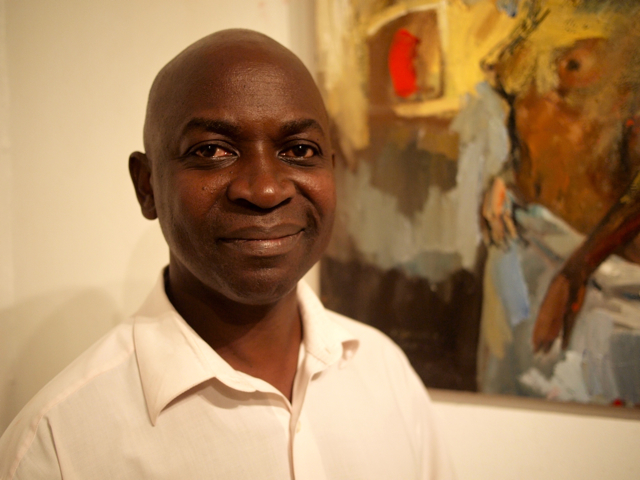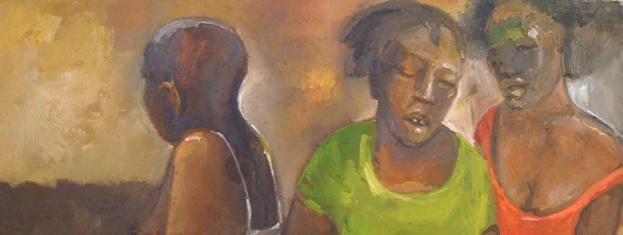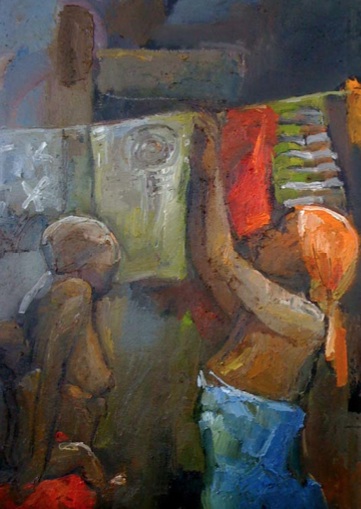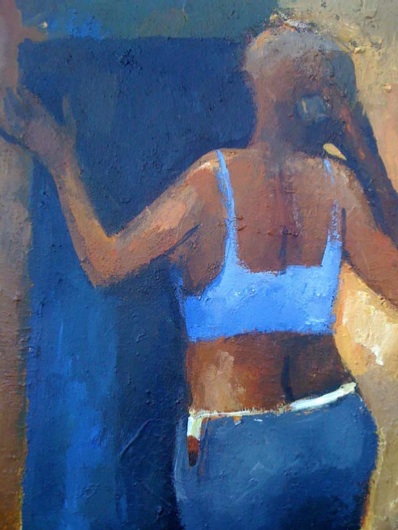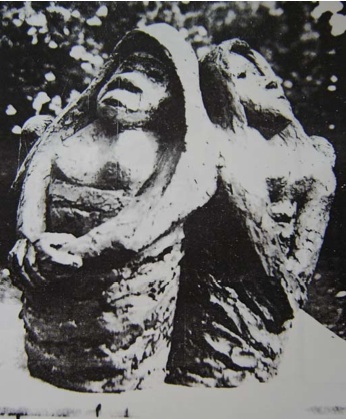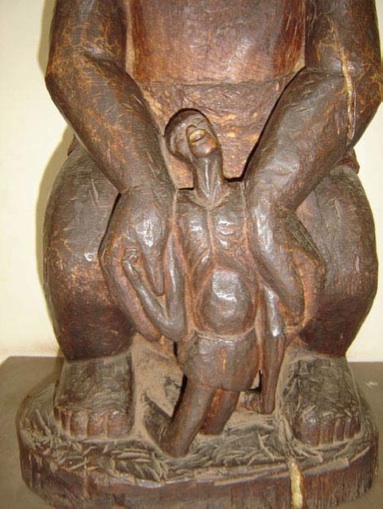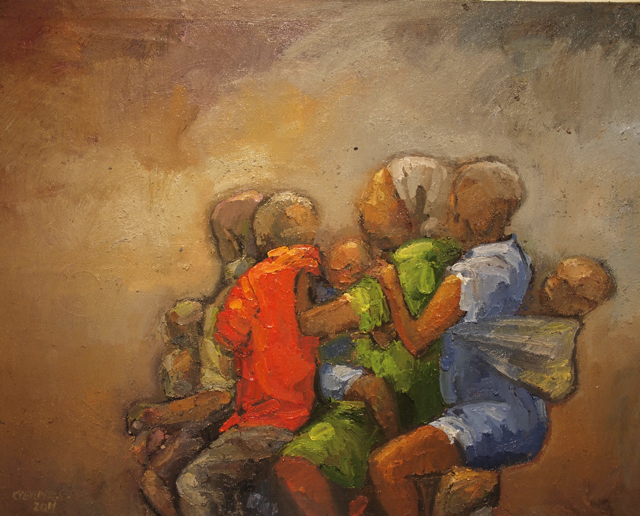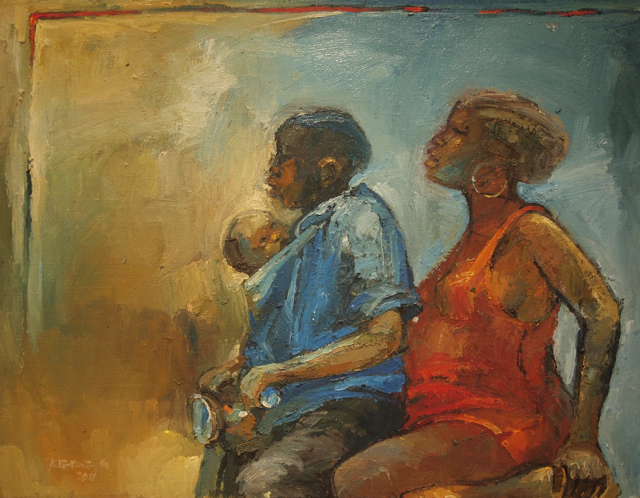On 14 October 2011 George William Kyeyune mounted his ‘The Kampala I Will Always Come Back To’. The exhibition showcased the artist’s recent paintings representing the hard sociopolitical struggles that the man/woman on the streets of Kampala goes through.
In this article I show and argue that as representations of life in Kampala, Kyeyune’s paintings are not portraits of individuals or groups. They are in the first place art. In the second, they are sanitised versions of reality intended to suit middle class and tourist aesthetic tastes. In the third place, they carry the risks of pandering to state propaganda.
By Angelo Kakande (F.J.)
Kyeyune is a prolific painter and sculptor. He graduated from the Margaret Trowell School of Industrial and Fine Arts (MTSIFA) with a Bachelor of Arts Fine Art degree in 1984.
Available evidence suggests that by the time he was in the second year of his undergraduate programme, Kyeyune had mastered the skill and expressionist style we see in his exhibition at Afriart Gallery.
For example, he had done his En Route from Mbale (1983), Mbale Trip (1983) and Suffering (1983). Three works which demonstrate the artist’s expressionist style and attention to emotion and form. He also did his Jesus Writing in the Sand (1983), a powerful painting in which he demonstrated his mastery of skill and understanding of colour theory.
The artist has lost some of the strength and control of media we see in these early works. First, and specifically in painting, at some point he resorted to using acrylics. He himself has conceded that acrylics are cheap and easy-to-handle. However, they have a kind of dryness which kills the work’s aesthetic value. He has now abandoned them; all the paintings in this exhibition are painted in oil.
Secondly, Kyeyune works on recycled canvasses. I have information to the effect that two clients refused to buy one of his works at Afriart Gallery exactly because the work was done on a recycled canvas. They argued that painting on used canvases is unprofessional.
Then, too, some students are bitter that he recycles their works. Unfortunately for them, university regulations do not permit students to claim their examination scripts. And yet dumping them would leave a dangerous carbon footprint. So Kyeyune has found how to recycle and put them to good use. As a result, he will, at least in the foreseeable future, most likely continue to paint on used canvasses.
The poor are happy in Kampala: Kyeyune’s view of life in the city
Kyeyune studied at the School of Oriental and African Studies, where he completed a PhD in Art History. When he returned from London people asked him to compare Kampala and London.
“There is nothing to compare,” he observed. “London is an organised city and Kampala lacks order” he added.
However, there is something in Kampala’s disorder which has grabbed Kyeyune’s attention because it “fascinates” him, namely: The poor in Kampala are happy.
“Today I saw a woman while driving to work. She was frying muwogo (cassava) in the most squalid conditions, sewerage [channels oozing past her], chicken pecking on the ground, etc. As a composition this was important. [It showed] how people carry on with this kind of life. Do they complain? They are poor but not unhappy. These things fascinate me.” (Kyeyune, personal interview, 14 November 2011).
In the above statement Kyeyune outlines the subject matter and political context of his exhibition. Clearly the artist does not imagine the serene, romantic Kampala which Philly Bongoley Lutaaya sang about in his Tugende e Kampala (Let’s Return to Kampala, 1990).
He also avoids the reference to criminality in the city in Akiiki Romeo’s song Kampala. He is also not like Bob Semakula, who in his video Ebibimba Bika from 2007 placed himself at the centre of poverty in the city.
He is just a keen observer of reality in Kampala.
Kyeyune’s reference to “a woman” must be contextualised. We see in his Gossip I (2011) a woman moving past two other women who “gossip about her”, he explained.
Now, this is the problem of having an artist discussing his work. He imputes meaning which is not easily accessible. In fact the moral code is not obvious. What is more accessible is that the artist attends to character and hairstyle, something which we also find in At the Salon (2011). In this we see a woman squats at the centre of the composition attended to by a male manicurist and a female hairdresser in front of another woman who looks on as linen dries on a washing line.
At the Salon strikes a certain moral code. Kyeyune is a Muganda from central Uganda. It is taboo for young or adult women to squat in Buganda. As Fred Ssebaale sang in his song Abasitamira Emmere (Women Who Squat while Preparing Food, 2007), a woman who squats can bring bad luck on the family, unemployment and poverty. This convention angers gender activists.
However, Kyeyune uses it as a trope to critique redundancy and unemployment in which many Kampalan residents are trapped.
This is the same message in Gossip II (2011) where a woman hangs linen on a cloths wire as another woman passes by with a baby stuck on her back. She stiffens as if to avoid contact with the linen or the other woman in the space.
The artist does not open any line of communication between the two. He however told me that the painting is about the effect of gossip. This reading is not clear unless if he meant that the two women are neighbours torn apart by feuds, rumours, gossip and envy, which are the kinds of vices common in Kampala and which Alex Mukulu sang about in his Bannakampala (People of Kampala, 2006).
Arguably, then, whether in groups or as an individual – like the skimpily dressed woman in blue in Telephone Call (2011) – Kyeyune uses the image of existential woman to engage a moral critique. He however goes beyond morals to critique the wider economic problems which afflict the poor in Kampala.
For example he is fascinated at the way slum dwellers surmount their economic woes. They operate petty “businesses” like open-air manicure, pedicure and hairdressing salons (and we see this depicted in At the Salon to which I referred earlier).
But they also operate roadside food stalls in which they roast plantains in order to support their families. Kyeyune’s Roadside Vendor (2011) affirms this reality; the woman is obviously struggling. She has however overcome poverty and managed to feed and raise a healthy baby.
In short, Kampalans are not miserable; “they are poor but happy”, the artist observes.
Commitment to societal problems and the risk of pandering to state propaganda
One can safely argue that Kyeyune’s Kampala I Will Always Come Back testifies to the artist’s commitment to societal problems. However, this position creates three challenges.
The first challenge can be traced back to Elimo Njau who was Trowell’s student in 1954-57. He graduated with a Diploma in Fine Art, taught at Makerere Demonstration School (Now Makerere College School) before returning to his native Tanzania. In 1962 he hosted His Master’s Hobby (1962) at the Uganda Museum which coincided with Uganda’s independence.
In the text accompanying the show, Njau called on artists to abandon the ivory tower and use art to emancipate their marginalised communities. This is how he did his Refugees (1962) to draw attention to the plight of refugees (mainly from Rwanda) in Uganda.
Njau’s call has been answered.
For example, General Elly Tumwine is a soldier, artist and art educator. He joined the rebellion which unseated the brutal Obote regime in 1986. He is a Member of Parliament representing the Uganda People’s Defence Forces (UPDF). Together with Hussein Kyanjo (Member of Parliament for Makindye), he has joined a bi-partisan effort to hold ministers accused of selfishly benefiting from the country’s oil wealth accountable although there is the risk that the targeted ministers are wrongly accused using unverified information.
Fred Mutebi uses print-making and painting as a medium to challenge bad governance. Daudi Karungi is currently exhibiting several paintings at Afriart Gallery, including two interesting paintings in which he makes a case for the right to speak. Bruno Sserunkuuma, whose pottery Kyeyune has collected, uses pottery to reconstitute the decadent nation-state.
All these artists are expressing their rights inscribed in Article 19 of the International Convention on Civil and Political Rights and Article 29 of the 1995 Constitution of Uganda.
It is inferable from his statement that Kyeyune is following a similar path. Unlike Tumwine and Karungi, however, he does not assert the right to speak. Unlike Mutebi and Serunkuuma, he does not boldly challenge or re-order the administration of the nation-state.
He does not see ways in which his slum dwellers have used other means, for example Walk-to-Work demonstrations, to speak out. Instead he subtly asks if the right to hold government accountable and deliver really exists.
His line of inquiry is relevant. There is a growing debate in Uganda on whether the right to hold government accountable can be exercised. Uganda has a trigger-happy police which in 2010 killed a baby and shot the womb of a pregnant woman claiming provocation. As an institution the UPDF is ready and willing to help the police in its attacks on civilians. Both security agencies always cite Article 43(2) of the Constitution of Uganda (the limitation clause) and ‘orders from above’ for purposes of circumscribing and abusing people’s right to speak up.
The question for Kyeyune then is: In the midst of growing repression and militancy, can Ugandans hold the government accountable?
Although the question is relevant, Kyeyune does not answer it. Instead he makes a subtle intervention which carries with it the second challenge, that is: the risk of pandering to state propaganda.
The second challenge
The second challenge harks back to Gregory Maloba (1922-2007) who was Trowell’s Kenyan student in 1940. He taught at MTSIFA until 1966 when he returned to Kenya. In 1941 Trowell mounted the Makerere Art Show (1941) to celebrate the official opening of Makerere University’s administration block (commonly known as the Main Building). Works produced by students from the nascent MTSIFA were exhibited, including Gregory Maloba’s Death (1941).
Currently exhibited in the threatened Uganda Museum (threatened because it is likely to be sold), Death represents an allegorical animalistic figure crushing a frail human being with its two bare hands. Death represents the contention that human beings may be vulnerable but they are indestructible. Death was mainly an inquiry into wood as a medium of artistic expression; it was a reference to western artistic vocabulary shaped by Maloba’s access to Jacob Epstein’s work and Trowell’s pedagogy.
However, the colonial polity, threatened by WWII, received Death differently. Its existential subject matter was seen as a representation of the brutality of the Nazis and the indestructibility of the Allied forces together with the population standing behind them.
Against this re-reading a successful fusion was built between high art and the official war propaganda. Maloba (together with others) was co-opted into the colonial rhetoric of WWII – the War Effort – and commissioned to paint pictures grounded in the official version of WWII. This art-state project culminated in the Exhibition of War Painting (1942) which was also taken to London.
Maloba was lucky he aligned himself with the victors. However Martin Heidegger was unlucky he aligned himself with the Nazis; his Being and Time (1927) was exploited for official Nazi propaganda. This connection left a permanent, indefensible, indelible bad mark on the philosopher’s legacy.
Kyeyune must weight the risks.
Already he has participated in the construction of the Heroes Monument (2007). Located at Kabamba military barracks in Western Uganda, the monument depicts President Museveni as the embodiment of the 1981-86 rebellion which overthrew Obote’s regime.
He also took part in the ‘CHOGM Project’ which involved the making of The Stride, a group sculpture which projected, rather than questioned, the official ideology and agenda.
I estimate that although not funded by the state, Kyeyune’s The Kampala I Will Always Come Back To may suit the official explanation of the current socioeconomic situation in the country.
If his Kampalans do not question the state, he does not use his art to clearly and forcefully help them. Instead he suggests that the poor have overcome their problems, poor children are healthy after all, bodaboodas, manicure and salons help people to overcome poverty. As such his critical tool is blunted.
His exhibition taps into a trajectory which has been exploited by the government to support the current economic programmes which have pushed many into the poverty the artist visualises.
The third challenge arises out of Kyeyune’s use of humour to create aesthetics.
The Kampala I Will Always Come Back To: Injustices lost in aesthetics?
In Boodaboda II (2011) and Bayuda (2011) the artist uses the trope of an exaggerated load without suggesting that the motorcycle is overwhelmed. That way the failed transport system is overcome.
Called bodabodas, motorcycles are a permanent feature on Kampala’s crowded streets. They are used by many of those who cannot afford personal cars. They are a convenient way of beating traffic jams. They are commonly overloaded and recklessly ridden – as it is seen in his Bodabooda III (2011) where a rider has loaded many adults and children on the same motorcycle.
As such, statistics from the national referral Hospital Mulago show that many accidents on Uganda’s roads result from the recklessness of bodaboda cyclists which the police has failed to control.
And yet through humour Kyeyune aestheticises (and thus sanitises) this recklessness. For instance in Boodaboda I (2011) he depicts a rider who has opened his shirt, creating a kangaroo-like pouch in which he places a child for safety. This is risky and reckless considering that the rider uncomfortably sits on the petrol tank of the motorcycle in order to create enough space for his pregnant passenger, his wife.
“He is lucky he has a bodaboda,” Kyeyune explains while contending that the man before us is not like many others whose women die at home owing to complications related to failure to get antenatal care. Others die in hospital owing to neglect.
Unable to find an ambulance, the man in Bodabooda I takes his wife to a health facility. He does not demand government action; he uses the only means available to him, his bodaboda. Through improvisation the man overcomes a life-threatening difficulty in a country where the healthcare system has collapsed.
Thus Kyeyune has reconstructed an act which borders on recklessness into triumph, benevolence and duty to family.
Equally reckless is Tebaagaliza (2011), in which a vehicle has broken down. Some passengers frantically look on; others resign themselves to their fate. The space is not identifiably urban. This ambiguity isolates the scene from the poorly planned and crowded city. It allows us to see the ability to overcome a problem. Thus a mechanic is working without a jack and without removing the load that suffocates the broken-down vehicle.
In our interview the artist explained that his works are “a deliberate, conscious effort”; they are not spontaneous. They are a systematic, deliberate, artistic inquiry into life as it is in the city.
He adds humour in order to create art: “[T]he comical part of it is the practical decision [the subject] has taken. It is that kind of humour [which gives effect to] both the injustice” and the artistic experience in which “colour theory and technical things” are satisfied, he said.
He added that the experiences he captures may be sad. He, however, veils them in humour which “animates” them thus allowing the buyer to use the “work to decorate [his/her] house” although there is a risk that sometimes this intervention “overwhelm[s] the subject matter”. (Kyeyune, personal interview, 14 November 2011).
To state it differently, The Kampala I Will Always Come Back To is a sanitised representation in which recklessness and economic injustice have been aestheticised for purposes of satisfying the bourgeoisie tastes of the middle class and tourist market which buys Kyeyune’s work.
As such humour removes his representations from their lived reality.
Conclusion
Being a representation in which indestructible individuals take charge of their destiny, The Kampala I Will Always Come Back To is grounded in an existentialist view which risks pandering to state propaganda.
Confronted with donor criticism (through Wikileaks and reductions in bilateral assistance), incessant public demonstrations, and mainly the Walk-to-Work demonstrations, the state would want to hear that individuals in the city are mastering their destiny.
I argue that Kyeyune’s voice, if visual, is a public testimony that the urban population is happy.
This message is risky. It confirms government’s view that things are not as bad as the opposition seems to “maliciously” portray in the international media (Facebook, BBC, Al Jazeera, etc).
However it has been rejected by the opposition. Besides, the depreciating shilling, runaway inflation, permanent power outages, rising unemployment and bloody riots currently raging in Kampala do not paint a picture of a poor but happy population.
Dr. Angelo Kakande has researched extensively on contemporary Ugandan art and the connection to politics. He is currently the Head of the Department of Design at MTSIFA.
